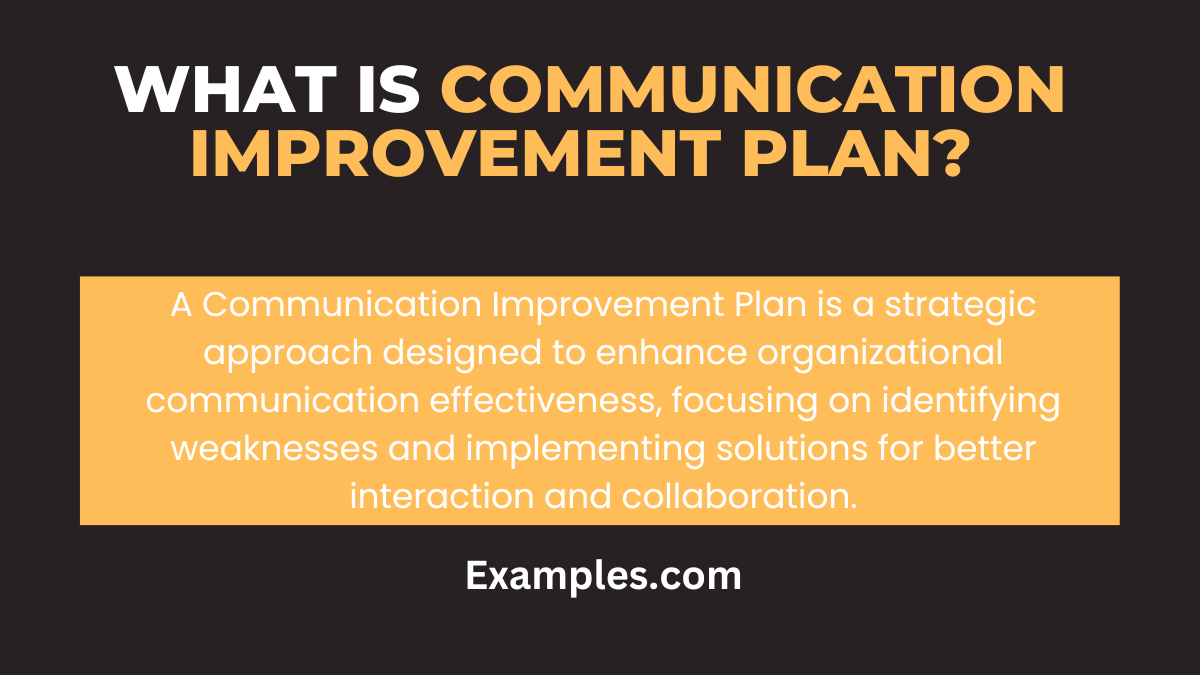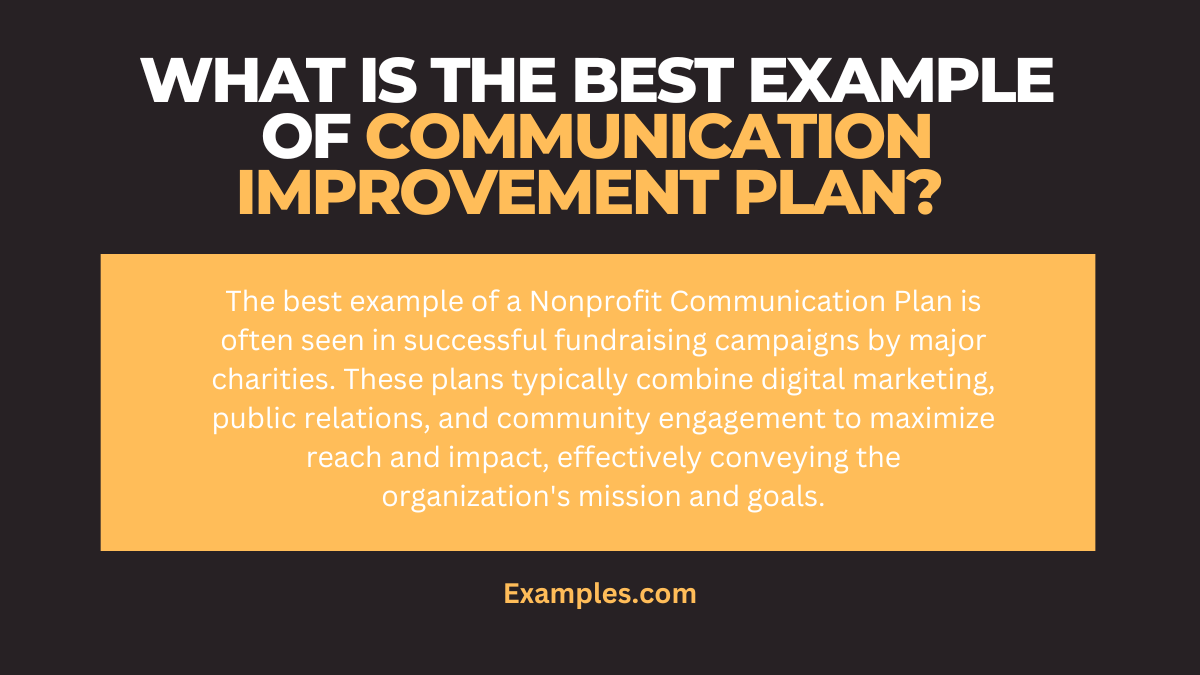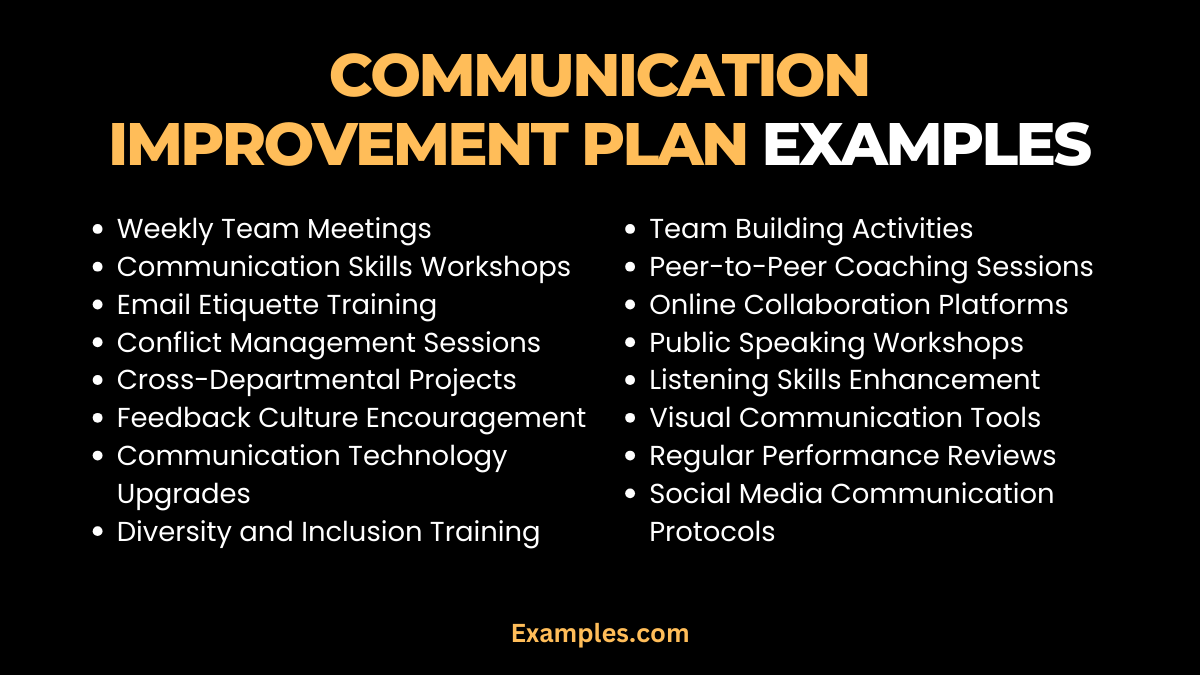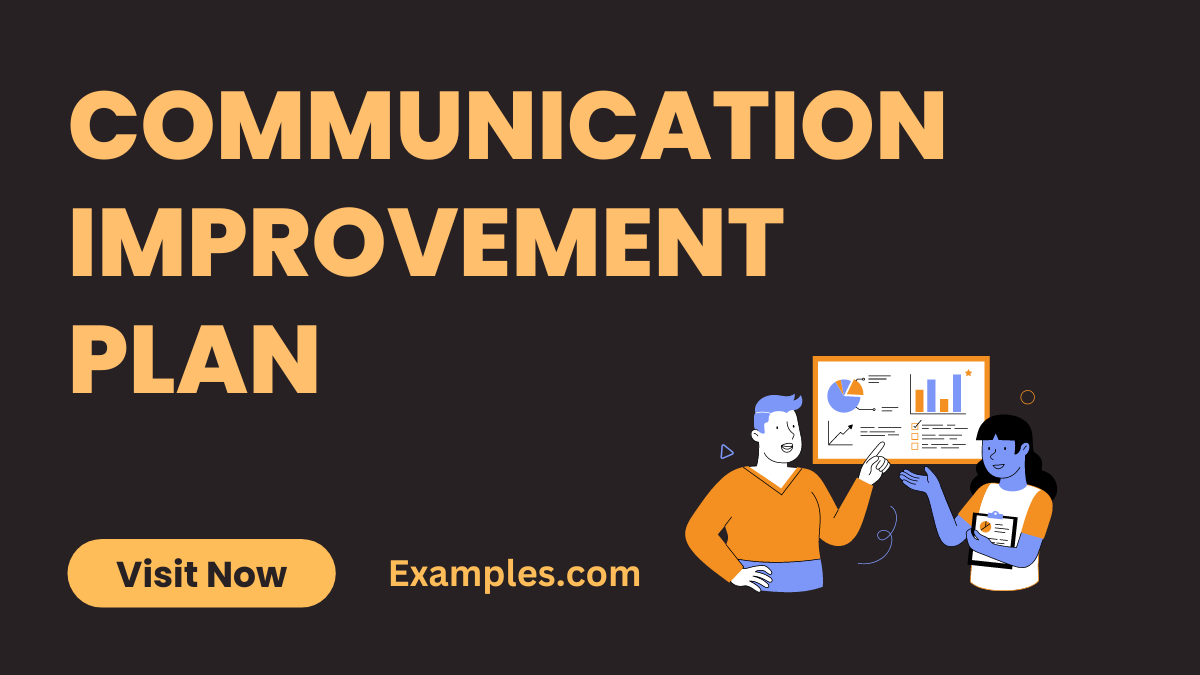19+ Communication Improvement Plan Examples
A Communication Improvement Plan is key to fostering effective workplace interactions. This guide delves into various communication examples and strategies, offering practical solutions for enhancing team dialogue. It addresses common communication challenges, provides actionable steps for improvement, and showcases real-world examples. Whether it’s refining interpersonal skills or optimizing organizational communication, this guide is an invaluable resource for professionals seeking to elevate their communication game and build a more cohesive and productive work environment.
Download Examples of Communication Improvement Plan PDF
What is Communication Improvement Plan? – Meaning

A Communication Improvement Plan is a strategic approach designed to enhance the quality and effectiveness of communication within an organization or team. It involves identifying areas in communication that need development, setting specific goals for improvement, and implementing strategies to achieve these goals. This plan is essential for improving team collaboration, understanding, and overall performance in a professional setting.
What is the best Example of Communication Improvement Plan?

The best example of a Communication Improvement Plan can be seen in a company-wide initiative to enhance internal communication. This involves conducting a thorough communication audit and assessment to identify weaknesses and areas for improvement. The plan may include steps like:
- Implementing regular team meetings and feedback sessions.
- Training programs for interpersonal communication skills development.
- Using digital communication tools to ensure clear and consistent messaging.
- Setting up mentorship programs to enhance team communication enhancement.
20 Communication Improvement Plan Examples

Creating a Communication Improvement Plan involves diverse strategies to enhance workplace interaction and effectiveness. These examples showcase a variety of approaches to address specific communication challenges, fostering a more collaborative and efficient work environment.
- Weekly Team Meetings:
- Cause: Lack of regular team updates.
- Fix: Implement structured weekly meetings for updates and feedback.
- Communication Skills Workshops:
- Cause: Inadequate interpersonal skills.
- Fix: Organize workshops focusing on effective communication Skills techniques.
- Email Etiquette Training:
- Cause: Miscommunication through emails.
- Fix: Provide training on clear and professional email communication.
- Conflict Management Sessions:
- Cause: Workplace conflicts.
- Fix: Conduct sessions on conflict resolution and effective dialogue.
- Cross-Departmental Projects:
- Cause: Siloed communication between departments.
- Fix: Initiate projects that require cross-departmental collaboration.
- Feedback Culture Encouragement:
- Cause: Lack of open feedback channels.
- Fix: Foster a culture where feedback is regularly sought and given.
- Communication Technology Upgrades:
- Cause: Outdated communication tools.
- Fix: Implement modern digital communication tools for better connectivity.
- Diversity and Inclusion Training:
- Cause: Cultural misunderstandings.
- Fix: Offer training on cross-cultural communication and inclusivity.
- Leadership Communication Coaching:
- Cause: Ineffective communication from leaders.
- Fix: Provide coaching for leaders on transparent and inspiring communication.
- Remote Work Communication Guidelines:
- Cause: Challenges in remote team communication.
- Fix: Establish clear guidelines and regular check-ins for remote teams
- Customer Service Communication Training:
- Cause: Ineffective customer interactions.
- Fix: Specialized training to enhance customer communication skills.
- Team Building Activities:
- Cause: Lack of team cohesion.
- Fix: Organize team-building events to foster better communication.
- Peer-to-Peer Coaching Sessions:
- Cause: Need for personalized communication development.
- Fix: Implement peer coaching for shared learning and improvement.
- Online Collaboration Platforms:
- Cause: Difficulty in remote collaboration.
- Fix: Utilize digital platforms for efficient team collaboration.
- Public Speaking Workshops:
- Cause: Fear of public speaking.
- Fix: Conduct workshops to boost public speaking confidence.
- Listening Skills Enhancement:
- Cause: Poor active listening habits.
- Fix: Training sessions focused on active listening techniques.
- Visual Communication Tools:
- Cause: Over-reliance on text-based communication.
- Fix: Introduce visual aids like infographics for clearer understanding.
- Regular Performance Reviews:
- Cause: Lack of feedback on communication performance.
- Fix: Implement a system for regular communication performance reviews.
- Social Media Communication Protocols:
- Cause: Inconsistent brand messaging on social media.
- Fix: Establish clear guidelines for brand communication on social platforms.
- Language Skill Development:
- Cause: Language barriers within diverse teams.
- Fix: Offer language training to facilitate better team communication.
Communication Performance Improvement Plan
A Communication Performance Improvement Plan focuses on enhancing the effectiveness and efficiency of communication within an organization. It includes assessing current communication practices, identifying areas for improvement, and implementing targeted strategies to enhance overall communication performance.
- Real-time Feedback System: Immediate feedback on communication efforts.
Example: “Your presentation was clear, but let’s work on making it more engaging next time.” - Regular Communication Audits: Evaluating the effectiveness of current communication methods.
Example: “This quarter’s audit will focus on how well our team communicates project updates.” - Advanced Presentation Skills Training: Enhancing presentation abilities for better clarity and impact.
Example: “Join our training session to learn advanced techniques for impactful presentations.” - Structured Meeting Agendas: Organizing meetings for maximum efficiency and clarity.
Example: “Let’s ensure our meetings are productive with a clear and structured agenda.” - Role-Playing for Difficult Conversations: Preparing for challenging communication scenarios.
Example: “Let’s role-play a difficult client interaction to improve our handling skills.”
Communication Skills Improvement Plan
A Communication Skills Improvement Plan aims to develop and refine the communication abilities of individuals or teams. This plan incorporates various techniques and practices to improve verbal, non-verbal, and written communication skills.
- Active Listening Workshops: Fostering better understanding and responsiveness.
Example: “These workshops will help us improve our active listening, enhancing team collaboration.” - Non-Verbal Communication Training: Understanding and using body language effectively.
Example: “Learn to read and use body language for more effective non-verbal communication.” - Writing Skills Enhancement Course: Improving clarity and professionalism in written communication Skills.
Example: “Our course will cover techniques to enhance your email and report writing skills.” - Assertiveness Training Program: Building confidence in expressing ideas and opinions.
Example: “Become more assertive in your communication with our specialized training program.” - Emotional Intelligence Development: Enhancing empathy and emotional understanding in communication.
Example: “This program will help us communicate more effectively by understanding emotional cues.”
Communication Improvement Plan for Employee
A Communication Improvement Plan for an employee is tailored to help individuals enhance their specific communication skills at work. It involves personalized strategies and activities aimed at improving the way they interact with colleagues, clients, and superiors.
- Mentorship for Communication Development: Guided learning from experienced colleagues.
Example: “Through mentorship, you’ll gain insights on improving your day-to-day communication.” - Personalized Feedback Sessions: Providing individualized feedback on communication styles.
Example: “Let’s discuss your recent project updates and how you can communicate them more effectively.” - Customized Communication Workshops: Workshops addressing specific communication weaknesses.
Example: “Join our custom workshop to work on areas of communication you struggle with.” - Regular Performance Reviews with Communication Focus: Concentrating on communication in performance evaluations.
Example: “In your next performance review, we will focus on your communication progress.” - Individualized Public Speaking Coaching: Personal coaching to enhance public speaking skills.
Example: “Personal coaching sessions will help you improve your confidence and skills in public speaking.”
Communication Improvement Action Plan
A Communication Improvement Action Plan involves specific steps and actions to improve communication within a team or organization. This plan is action-oriented, focusing on implementing practical solutions to enhance overall communication effectiveness.
- Implementing a Suggestion Box: Encouraging open feedback from all team members.
Example: “Your suggestions for improving team communication can be submitted anonymously in our suggestion box.” - Hosting Bi-weekly Communication Workshops: Regular workshops to practice and improve communication skills.
Example: “Join our bi-weekly workshops to practice effective team communication techniques.” - Introduction of Communication Tools: Using digital tools to enhance team communication.
Example: “We’re introducing Slack to streamline our team’s communication and collaboration - Enhanced Internal Feedback Systems: Encouraging open, constructive feedback within the team.
Example: “Please share your feedback through our new internal survey system.” - Mentorship Programs for New Employees: Easing communication challenges for newcomers.
Example: “Our mentorship program will help new team members adapt to our communication culture.”
How to Improve Communication Plan Skills in the Workplace?
Improving communication plan skills in the workplace involves a combination of strategy, training, and practice:
- Assessment and Feedback: Regularly assess communication effectiveness and gather feedback to identify areas for improvement.
- Training and Workshops: Invest in training sessions focused on enhancing specific communication skills like active listening, clear messaging, and public speaking.
- Utilize Technology: Implement and encourage the use of digital communication tools that facilitate clearer and more efficient interactions.
- Promote Open Dialogue: Foster an environment where open, honest communication is encouraged, and everyone feels comfortable sharing their thoughts and ideas.
- Set Clear Goals and Expectations: Clearly define communication goals and expectations to ensure everyone is aligned and understands their role in effective communication.
- Monitor and Review: Continuously monitor communication processes and review the plan regularly to make necessary adjustments for ongoing improvement.
What are the Tips and Tricks for a Communication Improvement Plan?
- Set Clear Goals: Define specific objectives for what you aim to improve in communication.
- Identify Communication Barriers: Recognize obstacles hindering effective communication, such as cultural differences or technology gaps.
- Invest in Training: Provide training sessions focusing on communication skills like active listening, clear articulation, and non-verbal cues.
- Encourage Feedback Culture: Foster an environment where constructive feedback is welcomed and acted upon.
- Utilize Technology: Leverage digital tools to facilitate easier and more efficient communication.
- Regular Monitoring and Adjustments: Continuously evaluate the effectiveness of communication strategies and make necessary adjustments.
- Promote Open Dialogue: Encourage open discussions to build trust and transparency within the team.
- Customize Communication Styles: Recognize and adapt to different communication styles of team members for better understanding.
Communication skills is a journey that leads to personal and professional growth. By following the strategies outlined in this article, you can take significant steps toward becoming a more effective communicator. Remember that communication is not just about words but also about active listening, empathy, and understanding your audience’s needs.
To further enhance your communication abilities, consider exploring additional resources from authoritative sources. Harvard University’s Division of Continuing Education provides valuable insights into effective communication in their blog post, 8 Ways You Can Improve Your Communication Additionally, the Community Tool Box from the University of Kansas offers a comprehensive guide on communication planning, which can deepen your understanding of this crucial skill
By incorporating these resources into your learning journey, you’ll be better equipped to excel in your personal and professional interactions, making a positive impact on your relationships and achieving your communication goals.



